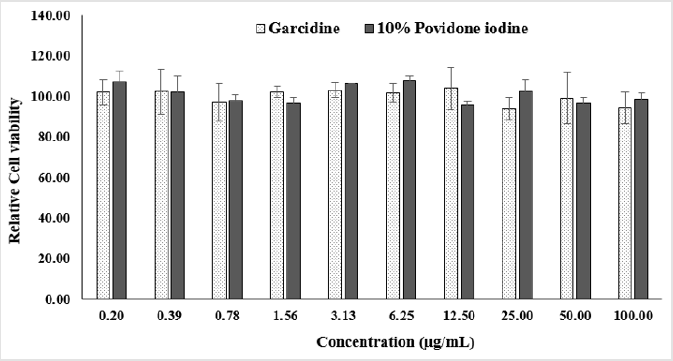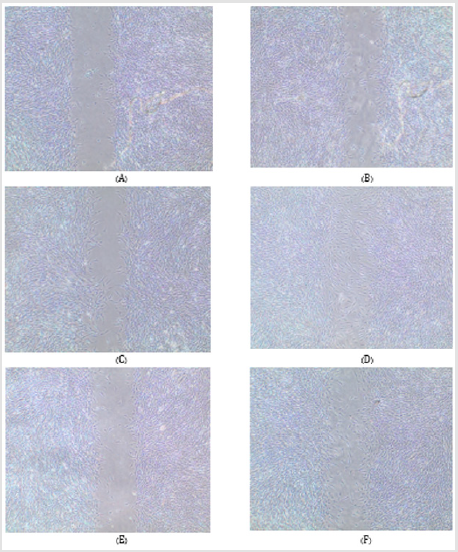Abstract
Wound healing is the survival process against disruptor of living cells or tissues. Many attempts have tried to develop the products for promoting wound healing process. Garcidine®, a hospital formula containing 10% w/v ethanolic extract of Garcinia mangostana Linn fruit peel in propylene glycol base, is the topical anti-septic product for treating open wound. This current study aimed to determine wound healing efficiency of Garcidine® by using fibroblast cell migration model. Cell migration of Garcidine® treated fibroblast cells was compared to that of 10%w/v povidone iodine. The results revealed that Garcidine® was superior to 10% w/v povidone iodine in increasing fibroblast cell migration within 12 hours of treatment. Cytotoxic effect on fibroblast cells was not evidenced in both formulations. Therefore, this finding suggests that Garcinia Mangostana Linn fruit peel ethanolic extract is the promising natural product for treating open wound due to the efficacy in increasing fibroblast cell migration.
Keywords: Garcinia Mangostana Linn; Cell Migration; Wound Healing
Introduction
Wound is the disruption of cellular and anatomical living tissue. It can be produced by chemical, physical and microorganism attacking the tissue and is a major cause of organ abnormal function and disability [1]. Wound healing is a survival process for protecting and regenerating damage tissue. The healing process is triggered since tissue injury; platelets are activated and attracted into the injury area. Platelet aggregation induces the release of clotting factor that results in the deposition of a fibrin clot at the site of injury. Immune cells also interact with fibrin clot and release the cytokines and growth factors such as interleukin-1 beta (IL- 1β), tumor necrosis factor alpha (TNF-α) and transforming growth factor beta (TGF-β). Fibroblasts cells obviously response to TGF-β and then perform collagen deposition for repairing the injury tissue [1,2]. Due to fibroblasts responsibility to collagen production, they are usually studied for estimating wound healing process by using cell migration and proliferation models [3]. Many studies used fibroblast cells for predicting wound healing promotion activity [1,3]. Garcinia mangostana Linn. has many chemical compounds that present various bio-activities? There was a study reported on wound healing promotion activity of G. mangostana in Spraque-Dawley rats by inducing skin epithelialization and wound contraction [4]. Moreover, xanthones isolated from G. mangostana presented potent anti-microbial [5,6] and anti-inflammatory activities [7,8]. Both activities play crucial role in wound healing promotion. Garcidine® is a topical anti-septic product containing G. mangostana peel extract in propylene glycol. The formula is formulated according to Thailand National List Essential Medicines recommendation [9]. Current study aimed to investigate wound healing promotion activity of Garcidine® by using fibroblast cell migration model.
Materials and Methods
Garcidine® (10% w/v Garcinia mangostana Linn fruit peel ethanolic extract in propylene glycol) was obtained from Chaopraya Abhaiphubejhr Hospital, Prachinburi Province, Thailand. The extraction was described in brief; dry G. mangostana fruit peel powder 600g was macerated with 95% ethanol 800 g for 24 hours. An extract solution was collected. The maceration process was repleted 3 times with fresh ethanol. The extract solutions were filtered and pooled before evaporation at 60°C using rotary evaporator. Garcidine® was prepared as 10% w/v G. mangostana fruit peel extract in propylene glycol. Scar-plate was purchased from Gibco (Gibthai, Thailand). Dulbecco’s Modified Eagle Medium (DMEM), Penicillin/Streptomycin, Trypsin and dimethyl sulfoxide (DMSO) and 3-2, 5-diphenyltetrazolium bromide were cell culture grade and purchased from Gibco (Invitrogen, USA). Fibroblast cells were isolated from neonatal circumcision foreskin. The process of skin collection was approved by Naresuan University Institutional Review Board with approval number 0140/62.
Fibroblast Cells Isolation
Dermis layer was dissected from foreskin and settled on cell culture plate. Culture tissue was maintained with DMEM containing 10% fetal bovine serum and 1% penicillin/streptomycin for 5 days. The cells were incubated in 95% RH, 5% CO2 environment at 37oC. They were then sub-cultured at 80% confluence.
Cytotoxic Testing
Fibroblast cells were added into 96 wells-plates with 1x104cells/ well and incubated for 24 hours. Then the cells were treated by Garcidine® or 10% w/v povidone iodine (a commercial topical antiseptic product) at various concentrations and re-incubated for 24 hours. Fifty microliters of 1 mg/ml MTT solution were added into each well. The incubation was done for formazan crystal formation for 3hours. Cell viability was determined by measuring absorbance at 595 nm comparing with the untreated cells [10].
Cell Migration Testing
Fibroblast cells were added into Scar-plate with 3.5x104 cell / channel. The cells were allowed to adhere for 24 hours in DMEM containing 10% fetal bovine serum and 1% penicillin/streptomycin. The septum was removed to create a channel between cells and then they were treated with Garcidine® or 10% w/v povidone iodine for 24 hours. Cell migration was observed and photographed using invert light microscope at 12 and 24 hours after treatment. Decrease of channel distance was calculated by using Image J computer software.
Results
Both Garcidine® and 10% w/v povidone iodine did not show any cytotoxic effect on fibroblast cells. The cell viability was greater than 90% in all treated concentration for both formulations. The results of cytotoxic test are showed in Figure 1. According to Figure 1, both Garcidine® and 10% w/v povidone iodine did not show any cytotoxic within the range 0.20 – 100.00μg/mL. Therefore, designed concentration of both samples for cell migration testing was 100μg/mL. Results of cell migration after treated with Garcidine® and povidone iodine were also compared with the control (untreated cells). After treated with test formulations, the cell morphology and migration were photographed at 12 and 24 hours. The images of cell migration are presented in Figure 2. Garcidine® obviously induced fibroblast cells migration across the channel space. On contrary, fibroblast cells treated with 10% w/v povidone iodine showed a limited migration when comparing to untreated cells and cells treated with Garcidine®. The decrease of channel distance presented in percent migration was calculated using ImageJ. The data indicated that fibroblast cells treated with Garcidine® was significantly decrease the channel distance more than that of the cells treated with 10%w/v povidone iodine and the control (Figure 3).
Figure 1: Relative cell viability after being treated with various concentration of Garcidine® or 10% w/v povidone iodine for 24 hours.
Figure 2: Cell migration after being treated with 100 μg/mL of 10% w/v povidone iodine for 12 hours (A) 24 hours (B) 100 μg/ mL of Garcidine® for 12 hours (C) 24 (D) and Control cells at 12 hours (E) and 24 (F).
Figure 3: Percent migration of fibroblast cells at 12 and 24 hours after being treated with Garcidine® or 10% povidone iodine; *significantly different from control cell p<0.05.
Discussion
The effectiveness of Garcidine® (10% w/v Garcinia mangostana Linn fruit peel ethanolic extract in propylene glycol) in promoting cell migration was evidenced. Garcidine®, the anti-septic product, has been used for treating fresh and chronic wounds in local Thai hospital according to Thailand National List Essential Medicines recommendation. The result revealed that Garcidine® was nontoxic on fibroblast cells. In addition, Garcidine® also induced fibroblast cells migration better than the commercially available topical anti-septic product, 10% w/v povidone iodine. Migration of fibroblast cells is a significant phenomenon for wound closure. They are the indicator of wound healing process [2]. Migration of Garcidine® treated cells was the effect of G. mangostana peel extract. The extract could promote wound healing by inducing the wound to be at epithelization stage [4]. In case of povidone iodine, the result indicated that fibroblast cells were limited in cell migration when comparing to Garcidine® and the control. There were reports indicated that povidone iodine inhibited human fibroblast proliferation [11], although it was diluted till below cytotoxic concentration [12]. According to the current study, G.mangostana fruit peel ethanolic extract is a promising topical anti-septic ingredient of natural origin for treating open wound dues to it affect not only for preventing bacterial infection but also for promoting wound healing without cytotoxic effect on fibroblast cells.
References
- Jagtap N, S S Khadabadi, IA Farooqui, VP Nalamwar, H A Sawarkar, et al. (2002) Development and evaluation of herbal wound healing formulations. Inter J of PharmTech Research 1(4): 974-4304.
- Broughton G, JE Janis, CE Attinger (2006) The basic science of wound healing. Plast Reconstr Surg 117(7 Suppl): 12s-34s.
- Jonkman JEN, Cathcart JA, Xu F, Bartolini ME, Amon JE, et al. (2014) An introduction to the wound healing assay using live-cell microscopy. Cell adhesion & migration 8(5): 440-451.
- Nainwal P, A Bhagla, D Nanda (2010) Study on antioxidant potential and wound healing activity on the aqueous extract of fruits of Garcinia mangostana. J Pharmacog and Herb Formul 1: 1-5.
- Janardhanan S, Mahendra J, Girija AS, Mahendra L, Priyadharsini V, et al. (2017) Antimicrobial Effects of Garcinia Mangostana on Cariogenic Microorganisms. J Clin and Diag Res 11(1): ZC19-ZC22.
- Cunha BL, França JP, Moraes AA, Chaves AL, Gaiba S, et al. (2014) Evaluation of antimicrobial and antitumoral activity of Garcinia mangostana L. (mangosteen) grown in Southeast Brazil. Acta Cir Bras 29 Suppl 2: 21-28.
- Tatiya-Aphiradee N, W Chatuphonprasert, K Jarukamjorn (2019) Antiinflammatory effect of Garcinia mangostana Linn. pericarp extract in methicillin-resistant Staphylococcus aureus-induced superficial skin infection in mice. Biomed Pharmacother 111: 705-713.
- Mohan S, Syam S , Abdelwahab SI , Thangavel N (2018) An antiinflammatory molecular mechanism of action of alpha-mangostin, the major xanthone from the pericarp of Garcinia mangostana: an in silico, in vitro and in vivo approach. Food Funct 9(7): 3860-3871.
- Commitee NLEM (2017) National List Essential Medicines (Herbal Drug), N.L.E. Medicines. Editor Ministry of Public Health: Nonthaburi p. 47-48.
- Van Meerloo J, GL Kaspers, J Cloos (2011) Cell Sensitivity Assays: The MTT Assay in Cancer Cell Culture IA Cree Editor. Humana Press 371: 237-245.
- Liu JX, Werner JA, Buza JA I I I, Kirsch T, Zuckerman JD, et al. (2017) Povidone-iodine Solutions Inhibit Cell Migration and Survival of Osteoblasts Fibroblasts and Myoblasts. Spine (Phila Pa 1976) 42(23): 1757-1762.
- Balin AK, L Pratt (2002) Dilute povidone-iodine solutions inhibit human skin fibroblast growth. ermatol Surg 28(3): 210-214.

 Short Communication
Short Communication



